Whether you are new to running or have decades under your belt, there’s no denying that a strong core, good posture and a healthy respiratory system will help you reach your potential and minimize the risk of an injury. It’s also no secret that running can cause soreness and stiffness, especially around the hips and legs. That’s where yoga can help you increase your performance, and reduce your risk of injury. Check out these yoga poses that stretch and help relieve muscle soreness and stiffness after running, as well as increasing core strength and improving posture…

How Can Yoga Help Runners?
There is actually no scientific evidence that stretching before a run can minimize your risk of an injury, and if you are cold and force yourself into stretching poses, you can actually do more harm than good. Instead, you should warm your muscles up, getting oxygen to start moving more fluidly around the body, by walking before your run. And the stretching should come afterwards, when your muscles are already warm and full of oxygen. As well as helping you recover after running, yoga also increases flexibility, improves joint and muscle health, eases aches and pains, improves posture, focus and respiratory function, and increases strength.

Yoga Poses For Runners
Just about any yoga class will help you stay healthy, strong and limber for running, but these poses work particularly well after a run, when you are warmed up and ready to stretch!

Forward Bend (Uttanasana)
This can be done standing up or seated. If you are standing, start in mountain pose with your big toes touching and about an inch between your heels. On an inhale, lift your arms up over your head, opening your chest and looking up. Make sure your knees are lifted and your core is engaged. Release your shoulder blades down your back. On an exhale, fold forward from the waist, leading with the heart, and keeping your back straight. Keep a bend in your knees if your legs are tight, and if you are comfortable enough to straighten them, make sure you still have a micro-bend in them (don’t lock the knee joints). Allow your spine and neck to lengthen, and release your head towards the floor. Your hands can rest either on the ground, either side of your feet or on your shins, or you can hug your legs or take hold of your elbows or behind your ankles. Relax and feel the release along the spine and the stretch along the back of your legs for at least five breaths.
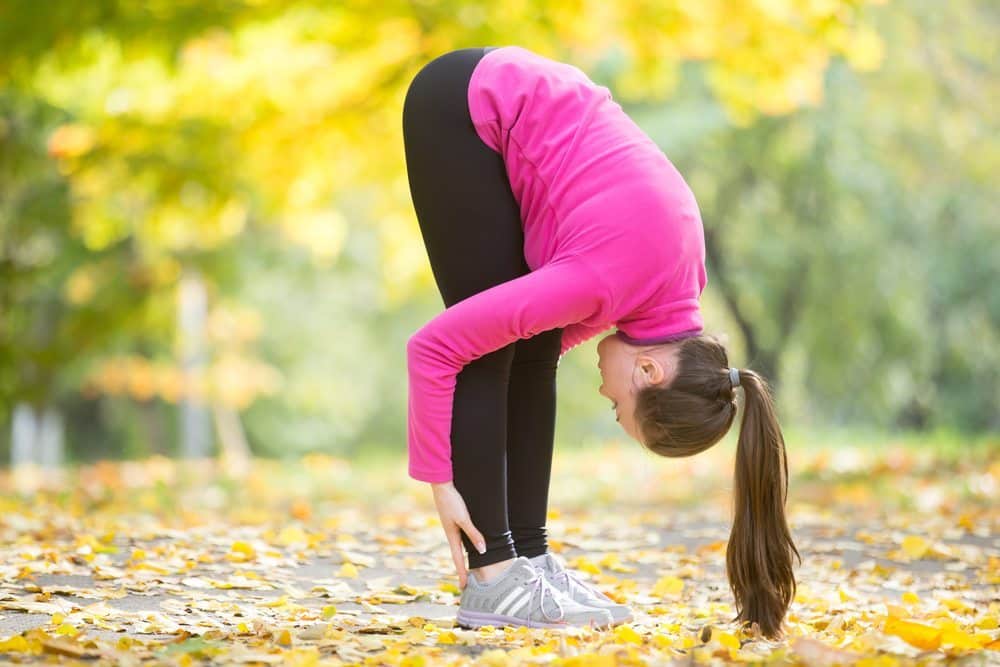
If you are practicing a seated forward bend, start in staff pose, with your torso and back straight and your legs out straight in front. Point your toes to the sky and lengthen the backs of your legs. Inhale and open your chest looking up and lean forward on an exhale, leading with your heart. Slide your hands down your legs and either hold the bottoms of your feet or rest your hands on your shins as you release your head, lengthening your spine and neck. If you have a yoga strap, you can practice this pose with the strap around your feet and walk your hands down the strap on an exhale. Hold here for at least five breaths.
Crescent Lunge
This is a fantastic pose for runners for a number of reasons. To begin with, it’s great for stretching your psoas, thighs and core, as well as practicing balance and strength. Start in uttanasana (forward bend) and bend your knees, placing your hands down on the mat or ground on either side of your feet. Step one leg back as far as you can, placing the ball of your foot down with your heel raised. Keep your front foot on the ground and look forward. Keep your front knee bent and, on an inhale, lift your arms up overhead. Make sure your front knee is directly over your ankle (not drifting to either side), and you can see your toes in front. Make sure your back leg is straight and sink your pelvis forward and down to feel the stretch around your back thigh. Hold for at least five breaths and repeat with the other leg.
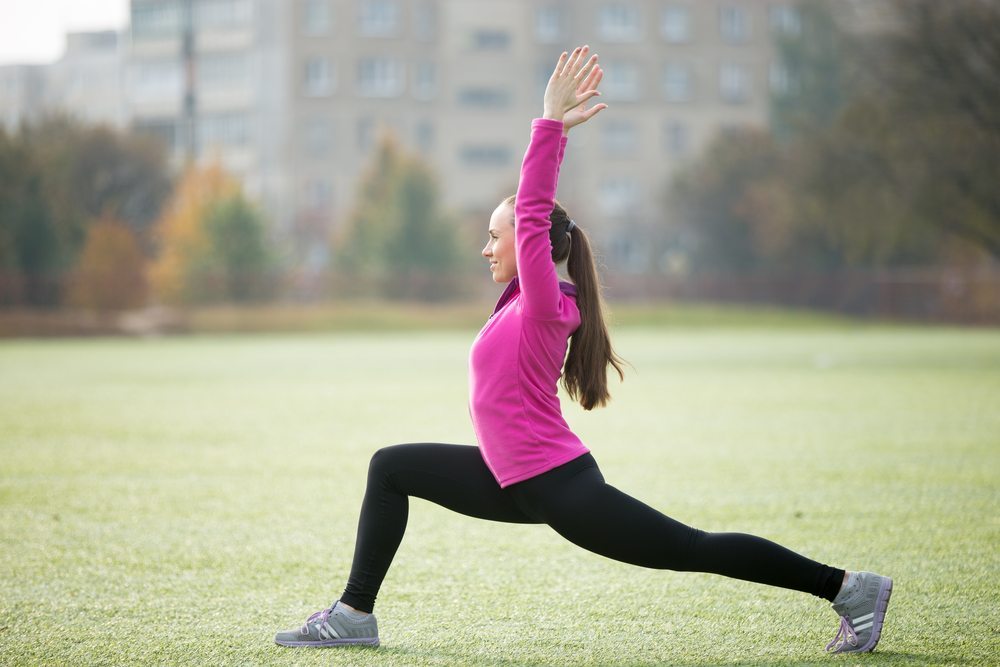
Warrior 2
From crescent lunge, place your back heel on the ground, with your toes pointing slightly forward. Your front heel should line up with the middle of your back foot. Turn your hips so that you are facing sideways and lift your arms out, one pointing forward and one pointing backwards, keeping your arms strong, but relaxing your shoulders away from your ears and letting your shoulder blades relax down your back. Turn your gaze over your front middle finger. Make sure you still have a good bend in your front leg, and your knee is directly over your ankle. Your back leg should be straight and your shoulders and hips should be in a straight line with your legs as if you were in between a narrow space between two walls. Engage your thighs as if you were pulling your heels towards each other. Engage your core and very slightly turn your tailbone towards the ground to make sure you are not arching and collapsing into your lower back. Hold for five to 10 breaths. Don’t repeat on the other side until you’ve practiced reverse warrior…
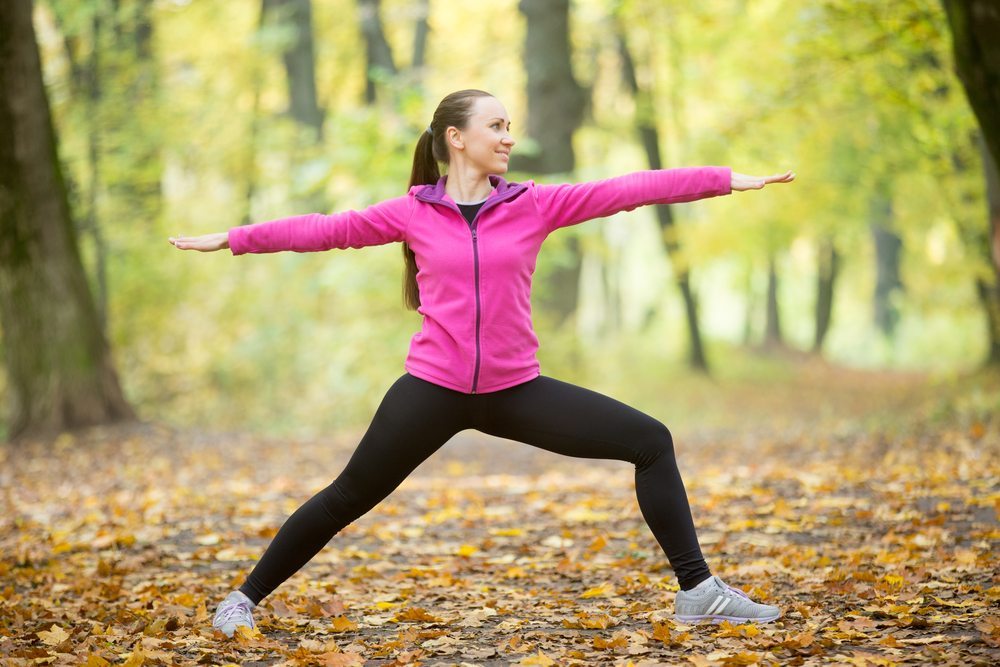
Reverse Warrior
From warrior two, turn your front palm towards the sky and place your back palm on your back thigh. On an inhale, lift your front arm up to the sky, and on an exhale, bend from your side towards the back of the room, sliding your hand down your leg. Turn your gaze to the sky and take at least five breaths. This is a great pose to stretch the side of your body. Once you’ve finished on one side, move into warrior two and then reverse warrior on the other side.
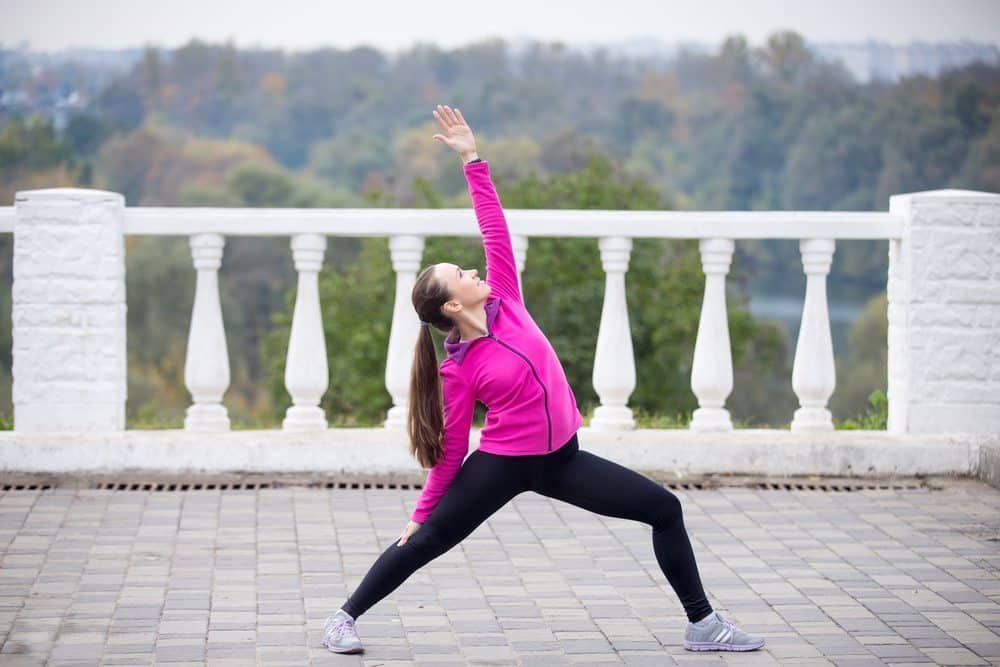
Extended Triangle Pose (Trikonasana)
Triangle is a great balancing pose that stretches the legs, side of the body and is actually very relaxing and therapeutic at the same time. It specifically targets the thighs, knees and ankles, stretching and strengthening them, as well as stretching and releasing the hips, groins, hamstrings, calf muscles, shoulders, chest and spine. It improves digestion, relieves stress and releasing tightness in the body after running.
You can move into triangle pose from warrior two by first straightening the front leg. Keep your hips and shoulders side on over your legs, lengthways on your mat and on an inhale, hinge forward with the upper body, stretching your front arm forward. On an exhale, bend down from your hip joint (not your waist) and send your front hand down towards your front foot, lifting your back arm up overhead so that they are in a straight line. Your hips should be stacked on top of each other and so should your shoulders. In other words, don’t let your top hip or top shoulder fall forward. You should be able to fit your body between two tight walls. Your front arm doesn’t need to reach all the way to the mat if that causes your hip or shoulder to fall forward. Instead, slowly move into the pose, sliding your hand down your front leg until you reach your maximum while keeping your alignment correct. Hold this pose for 10 breaths and when you’re ready to release, engage your core and lift back up on an inhale. Repeat on the opposite side.

Dancer’s Pose
This pose releases and stretches the body while testing strength, flexibility and balance. It is an extremely beneficial pose for runners. Start in mountain pose and ground down into your left foot, finding a still spot to focus your gaze on in front of you. Lift your right foot backwards, bending from the knee. Take hold of your ankle with your right hand and find stillness and focus holding there. Your right thigh might feel tight, and, if it does, hold the pose here for a few breaths before deepening it. When you are ready, lift your right leg out and back, straightening your right arm back while still holding the ankle. Lift your chest and allow it to open, bending into your back. Keep your hips squared off and don’t let the right hip open out to the side. Use your left arm to balance you by lifting it out in front. Keep your head and gaze up and forward, holding the pose and balancing for at least five breaths. When you are ready to release the pose, slowly and gently bring your right foot back towards your buttocks, release your grasp from the ankle and gently put your foot back to the ground. Shake out your legs a little and then repeat on the opposite side.
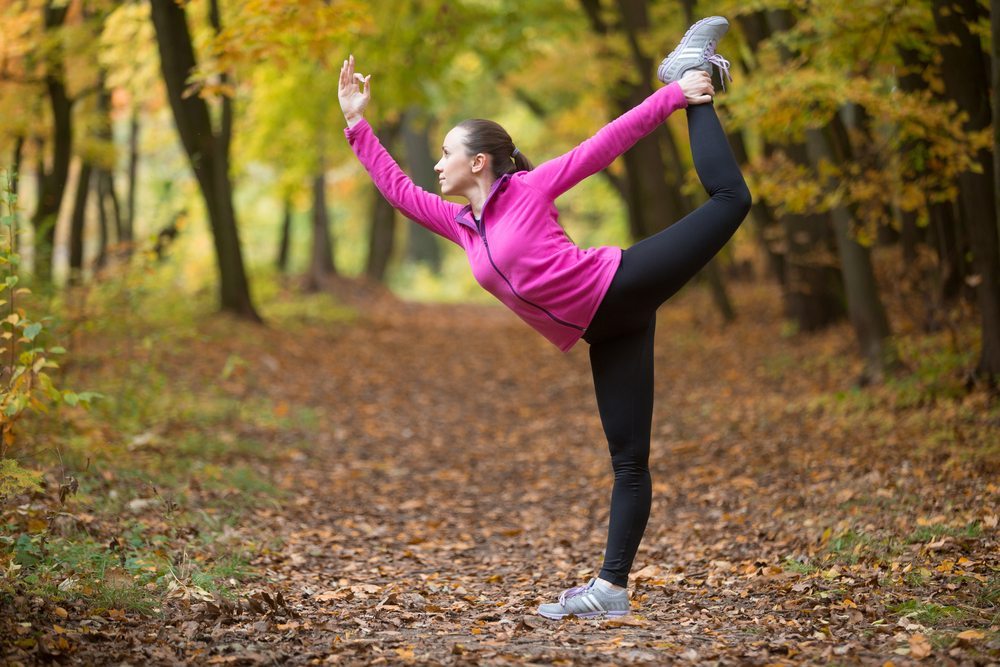
Wide-Legged Forward Bend
This is a fantastic pose to stretch your inner thighs and groin and strengthen your hips while releasing your spine and neck. It is also a very relaxing, restorative pose. Start opening your legs lengthways along the mat, standing as wide as you comfortably can. Slightly pigeon-toe your feet, and place your hands on your hips. On an inhale, you can take a slight backbend, engaging the core and looking up, opening your chest. As you exhale, hinge forward from the hips, leading with your heart and keeping your back straight. Place your hands on the ground and take an inhale, really straightening your back and looking forward. On your next exhale, release your head and neck down, lengthening the spine and releasing the back and neck. Allow the crown of your head to face downwards, either resting on the ground or floating. Hold here for at least 10 breaths. You can also give the sides of your body a bit more of a stretch by moving both hands to one foot for a few breaths and then repeating on the other side. When you are ready to come up, engage your thighs and core, place your hands back on your hips and lift back up with a straight back on an inhale.
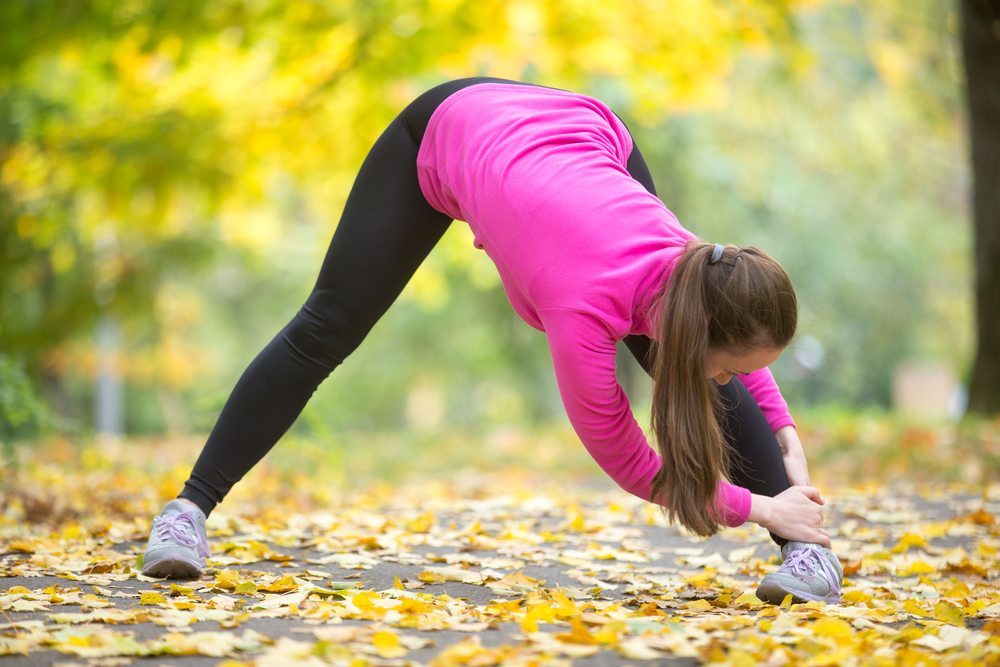
Camel Pose (Ustrasana)
This is a fantastic backbend that really stretches your chest, abdominal muscles, pelvis, psoas and thighs. In other words, it completely stretches the front of your body while strengthening your back muscles and improving posture. Start by kneeling on the floor with your knees hip distance apart, lifting up away from your heels so that you’re in an L-shape. Slightly rotate your thighs inwards and firm your glutes, but don’t engage them fully. Draw your pelvis slightly forward and lengthen your tailbone towards the ground so that you don’t collapse into your lower back when you move into the pose. Press your shins and feet into the floor and rest your hands on your lower back with your fingers pointing down. On an inhale, lift your chest up and out, pressing your shoulder blades down your back ribs. Start to lean back, keeping your tailbone and shoulder blades firm. If this feels like enough of a stretch along the front of the body, you can hold the pose here, but if you’re a bit more flexible and experienced, you can move into full camel pose by carefully placing your hands on your heels one at a time, moving deeper into the backbend. Lift your pelvis out, stretching your thighs even more, and make sure you are not collapsing into your lower back. If the pose feels alright, you can release you head back, stretching along the throat. Hold for five breaths, and when you are ready to release, firm your thighs and release one hand, rolling your head and body around the other side and lifting back up. Move into child’s pose from here to release the back by sitting your buttocks onto your heels, stretching your arms out in front and relaxing your forehead onto the ground, lengthening the spine.
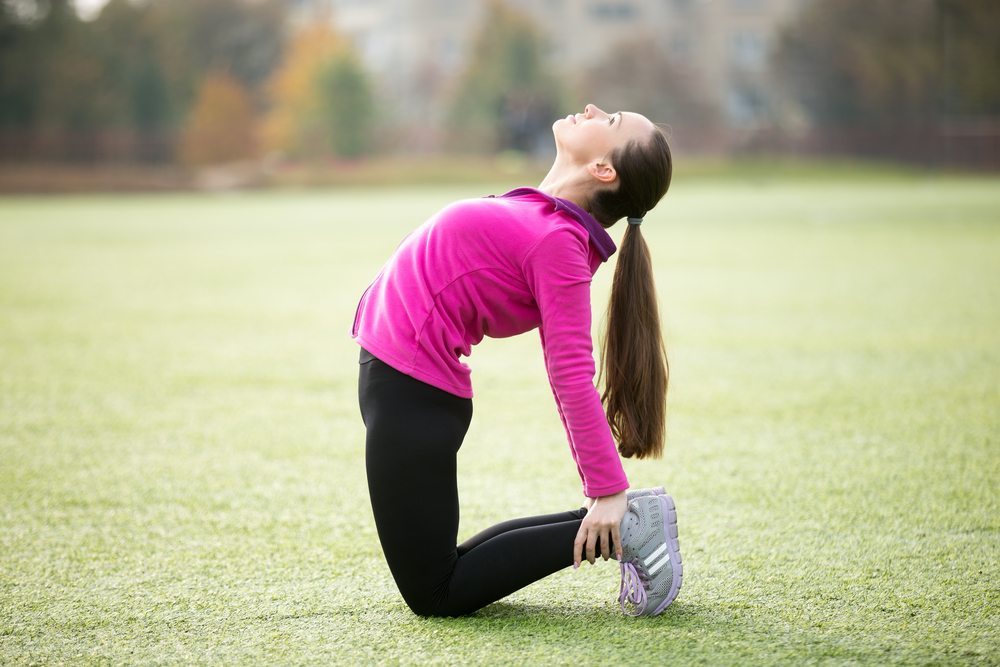
King Pigeon Pose (Eka Pada Rajakapotasana)
Running can cause your hips to become very stiff and sore, and you really can’t beat pigeon pose for a post-run hip stretch. This is a deep and powerful pose that not only relaxes tightness and tension by stretching large muscles, but also releases stress from the body, making it a very therapeutic pose. You can move into this pose from downward facing dog by bringing your right leg forward in between your hands and setting the outside of your leg down with your ankle behind your left hand and your knee behind your right hand. Depending on your flexibility, you might not be able to sit your lower leg in a straight line behind your hands, but that’s fine if it’s on a bit of an angle with your foot back towards your left hip. As you exhale, start to lower your torso over your leg and towards the ground. You can rest your forearms down on the mat, or, for a deeper stretch, lay your chest and forehead down on the mat with your arms stretched out in front. Stay here for 10 to 20 breaths, or more if you feel like using it as a long restorative pose. You can then turn the stretch into a heart opener and psoas/thigh stretch as well by sitting your upper body back up, curling your left leg up and taking hold of your foot with your left hand. Push your foot into your hand and your hand in your foot feeling that deep stretch along the left psoas and thigh and allowing the pose to open and stretch your chest. When you’re ready to move out of pigeon pose, place your palms firmly back down on the mat and lift back into downward facing dog, twisting and bending your knees one at a time to release your hips and bring life back into your leg. Repeat on the other side.
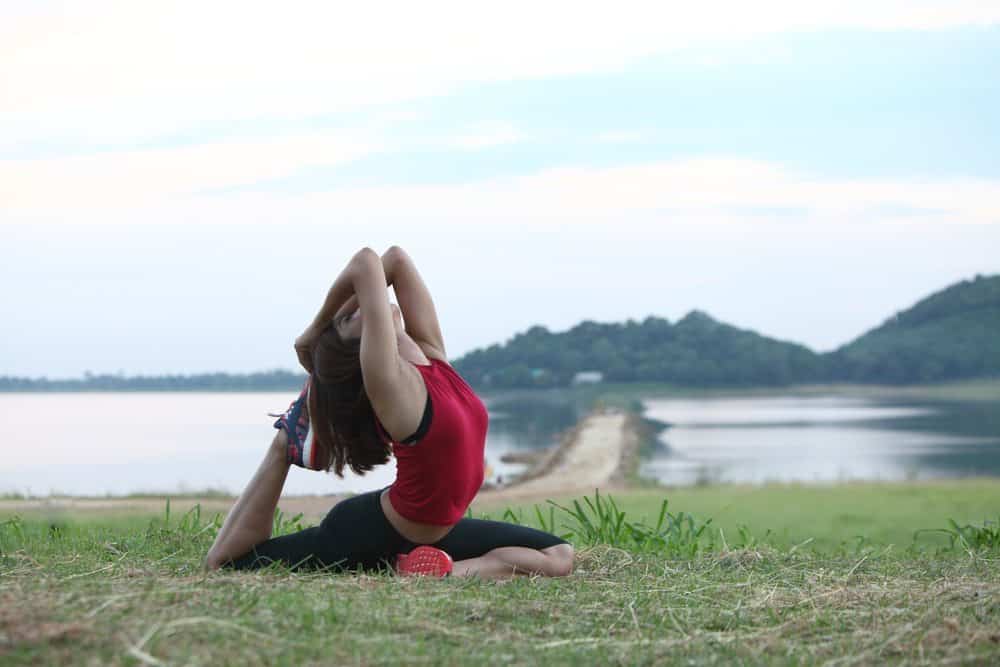
Seated Spinal Twist
Twisting your spine is a great way of restoring the body, winding down after exercising, relieving stress and stiffness and stretching the back and spine. Start in staff pose, sitting up straight with your legs out in front. Bend your right knee and lift your leg, placing your foot down on the other side of your left leg. Keep your left foot engaged with your toes pointing to the sky and place your left hand on your right knee or outer thigh. On an exhale, twist from your core to the right and place your right hand on the ground behind you. Inhale and lengthen your spine, then as you exhale, twist a little deeper. Hold here for at least five breaths and repeat on the other side.



